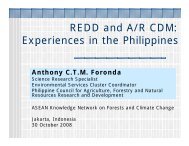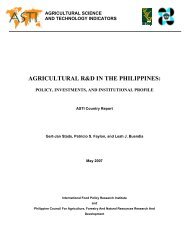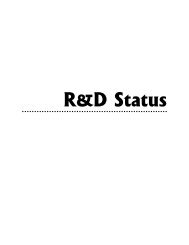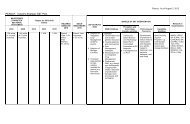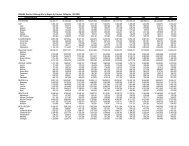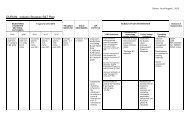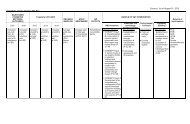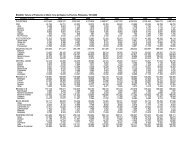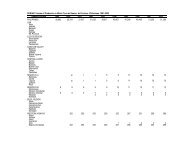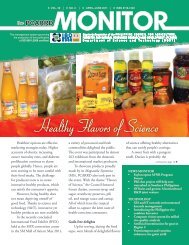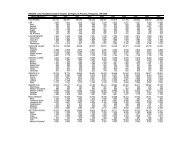Download PDF - pcaarrd - Department of Science and Technology
Download PDF - pcaarrd - Department of Science and Technology
Download PDF - pcaarrd - Department of Science and Technology
Create successful ePaper yourself
Turn your PDF publications into a flip-book with our unique Google optimized e-Paper software.
Technological Milestones<br />
○ ○ ○ ○ ○ ○ ○ ○ ○ ○ ○ ○ ○ ○ ○ ○ ○ ○ ○ ○ ○ ○ ○ ○ ○ ○ ○ ○ ○ ○ ○ ○ ○ ○ ○ ○ ○ ○ ○ ○ ○ ○ ○ ○ ○ ○ ○ ○ ○ ○ ○ ○ ○ ○ ○ ○ ○ ○ ○<br />
R&D Investments<br />
In 1999, the <strong>Department</strong> <strong>of</strong> <strong>Science</strong> <strong>and</strong><br />
<strong>Technology</strong> (DOST) recorded 431 fruit<br />
research projects with a total budget <strong>of</strong><br />
P145.4 M. Mango had the most number <strong>of</strong><br />
research projects <strong>and</strong> the largest budget<br />
(39%), followed by banana (27%). Next were<br />
durian (7%), cashew (5%), <strong>and</strong> papaya (4%)<br />
(Pabuayon, 2000).<br />
By institution, there were more<br />
researches conducted in line government<br />
agencies than in state colleges <strong>and</strong><br />
universities (SCUs). Among the SCUs,<br />
the University <strong>of</strong> the Philippines Los<br />
Baños (UPLB) had the biggest share<br />
(32.92%), with a total budget for fruit<br />
research <strong>of</strong> P59.09 M; followed by the<br />
University <strong>of</strong> Southern Mindanao (USM),<br />
with 3.03% <strong>of</strong> the total budget.<br />
In 1993–1997, PCARRD embarked on a<br />
P5.6-M comprehensive technology transfer<br />
<strong>and</strong> commercialization program for mango.<br />
To sustain the initial gains from this<br />
program, PCARRD launched the research<br />
project entitled, “Enhancing Productivity <strong>of</strong><br />
the Philippine Mango Industry (EPPMI)”<br />
with a budget <strong>of</strong> P12 M. Almost<br />
simultaneous to this, an even bigger<br />
program dubbed as “Mango Information<br />
Network (MIN),” which is a world-wide<br />
web-based information service was<br />
established in 1999, with a total budget <strong>of</strong><br />
P20 M from the United Nations Development<br />
Programme (UNDP), DOST, <strong>and</strong><br />
PCARRD.<br />
The banana industry has been included<br />
in several national programs such as the<br />
<strong>Science</strong> <strong>and</strong> <strong>Technology</strong> Agenda for<br />
National Development (STAND) <strong>of</strong> DOST,<br />
the High Value Commercial Crops Program<br />
(HVCC) <strong>of</strong> the <strong>Department</strong> <strong>of</strong> Agriculture<br />
(DA), <strong>and</strong> the Investment Priorities Plan<br />
(IPP) <strong>of</strong> the Board <strong>of</strong> Investments-<br />
<strong>Department</strong> <strong>of</strong> Trade <strong>and</strong> Industry (BOI-<br />
DTI.)<br />
Under the STAND Program, activities<br />
promote increased production <strong>of</strong> quality<br />
fruits to sustain competitiveness in the<br />
world market. Activities which were funded<br />
by DOST included mass production <strong>of</strong><br />
virus-free planting materials through tissue<br />
culture, use <strong>of</strong> diagnostic kits for rapid<br />
diagnosis <strong>of</strong> viral diseases, screening <strong>of</strong><br />
different cultivars for resistance to major<br />
pests, further studies on bugtok disease,<br />
improved management system for saba,<br />
development/improvement <strong>of</strong> products from<br />
saba for export, <strong>and</strong> field <strong>and</strong> in vitro<br />
maintenance <strong>of</strong> banana germplasm.<br />
Researches on biotechnology dealt with<br />
the development <strong>of</strong> homogenic banana<br />
varieties resistant to bunchy top disease<br />
through genetic engineering <strong>and</strong> mutation<br />
breeding. For the period 1998–2000,<br />
biotechnology research for fruits had a total<br />
budget <strong>of</strong> P47.57 M. Banana had more than<br />
half <strong>of</strong> the pie (55%), followed by durian with<br />
15.77%, papaya with 13.67%, <strong>and</strong> mango<br />
with 11.35%. Pili had a share <strong>of</strong> 4.20%.<br />
PCARRD also embarked on a P4.9-M<br />
program to enhance the productivity <strong>of</strong> the<br />
Saba industry through the development <strong>of</strong><br />
a quality assurance program from<br />
production, h<strong>and</strong>ling, <strong>and</strong> processing.<br />
16 ............................................................................................................. R&D Status <strong>and</strong> Directions



